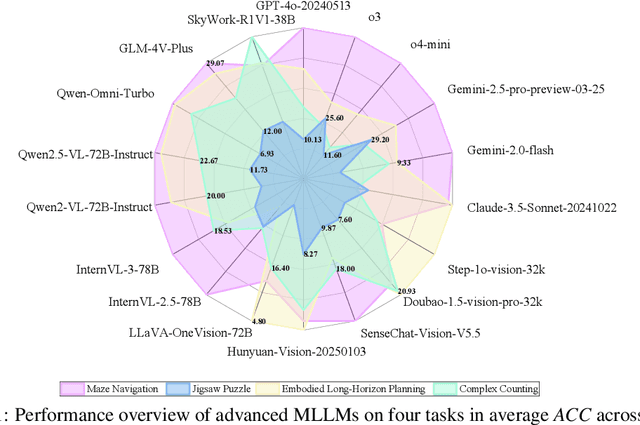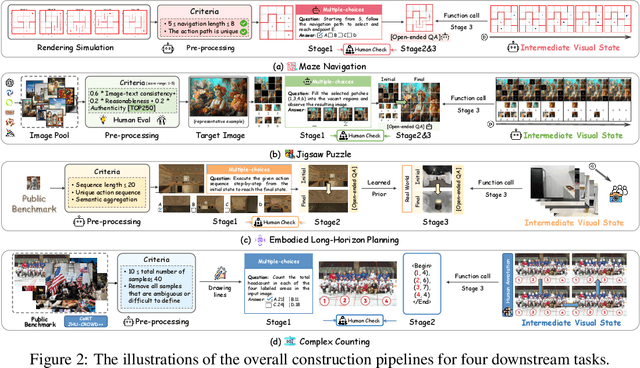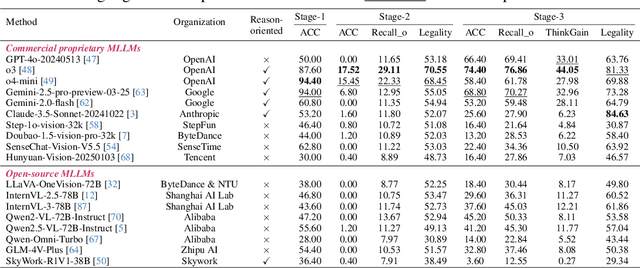Junxiao Xue
A Trustworthy Method for Multimodal Emotion Recognition
Aug 11, 2025Abstract:Existing emotion recognition methods mainly focus on enhancing performance by employing complex deep models, typically resulting in significantly higher model complexity. Although effective, it is also crucial to ensure the reliability of the final decision, especially for noisy, corrupted and out-of-distribution data. To this end, we propose a novel emotion recognition method called trusted emotion recognition (TER), which utilizes uncertainty estimation to calculate the confidence value of predictions. TER combines the results from multiple modalities based on their confidence values to output the trusted predictions. We also provide a new evaluation criterion to assess the reliability of predictions. Specifically, we incorporate trusted precision and trusted recall to determine the trusted threshold and formulate the trusted Acc. and trusted F1 score to evaluate the model's trusted performance. The proposed framework combines the confidence module that accordingly endows the model with reliability and robustness against possible noise or corruption. The extensive experimental results validate the effectiveness of our proposed model. The TER achieves state-of-the-art performance on the Music-video, achieving 82.40% Acc. In terms of trusted performance, TER outperforms other methods on the IEMOCAP and Music-video, achieving trusted F1 scores of 0.7511 and 0.9035, respectively.
AD-AVSR: Asymmetric Dual-stream Enhancement for Robust Audio-Visual Speech Recognition
Aug 11, 2025Abstract:Audio-visual speech recognition (AVSR) combines audio-visual modalities to improve speech recognition, especially in noisy environments. However, most existing methods deploy the unidirectional enhancement or symmetric fusion manner, which limits their capability to capture heterogeneous and complementary correlations of audio-visual data-especially under asymmetric information conditions. To tackle these gaps, we introduce a new AVSR framework termed AD-AVSR based on bidirectional modality enhancement. Specifically, we first introduce the audio dual-stream encoding strategy to enrich audio representations from multiple perspectives and intentionally establish asymmetry to support subsequent cross-modal interactions. The enhancement process involves two key components, Audio-aware Visual Refinement Module for enhanced visual representations under audio guidance, and Cross-modal Noise Suppression Masking Module which refines audio representations using visual cues, collaboratively leading to the closed-loop and bidirectional information flow. To further enhance correlation robustness, we adopt a threshold-based selection mechanism to filter out irrelevant or weakly correlated audio-visual pairs. Extensive experimental results on the LRS2 and LRS3 datasets indicate that our AD-AVSR consistently surpasses SOTA methods in both performance and noise robustness, highlighting the effectiveness of our model design.
eMotions: A Large-Scale Dataset and Audio-Visual Fusion Network for Emotion Analysis in Short-form Videos
Aug 09, 2025Abstract:Short-form videos (SVs) have become a vital part of our online routine for acquiring and sharing information. Their multimodal complexity poses new challenges for video analysis, highlighting the need for video emotion analysis (VEA) within the community. Given the limited availability of SVs emotion data, we introduce eMotions, a large-scale dataset consisting of 27,996 videos with full-scale annotations. To ensure quality and reduce subjective bias, we emphasize better personnel allocation and propose a multi-stage annotation procedure. Additionally, we provide the category-balanced and test-oriented variants through targeted sampling to meet diverse needs. While there have been significant studies on videos with clear emotional cues (e.g., facial expressions), analyzing emotions in SVs remains a challenging task. The challenge arises from the broader content diversity, which introduces more distinct semantic gaps and complicates the representations learning of emotion-related features. Furthermore, the prevalence of audio-visual co-expressions in SVs leads to the local biases and collective information gaps caused by the inconsistencies in emotional expressions. To tackle this, we propose AV-CANet, an end-to-end audio-visual fusion network that leverages video transformer to capture semantically relevant representations. We further introduce the Local-Global Fusion Module designed to progressively capture the correlations of audio-visual features. Besides, EP-CE Loss is constructed to globally steer optimizations with tripolar penalties. Extensive experiments across three eMotions-related datasets and four public VEA datasets demonstrate the effectiveness of our proposed AV-CANet, while providing broad insights for future research. Moreover, we conduct ablation studies to examine the critical components of our method. Dataset and code will be made available at Github.
HOLA: Enhancing Audio-visual Deepfake Detection via Hierarchical Contextual Aggregations and Efficient Pre-training
Jul 30, 2025Abstract:Advances in Generative AI have made video-level deepfake detection increasingly challenging, exposing the limitations of current detection techniques. In this paper, we present HOLA, our solution to the Video-Level Deepfake Detection track of 2025 1M-Deepfakes Detection Challenge. Inspired by the success of large-scale pre-training in the general domain, we first scale audio-visual self-supervised pre-training in the multimodal video-level deepfake detection, which leverages our self-built dataset of 1.81M samples, thereby leading to a unified two-stage framework. To be specific, HOLA features an iterative-aware cross-modal learning module for selective audio-visual interactions, hierarchical contextual modeling with gated aggregations under the local-global perspective, and a pyramid-like refiner for scale-aware cross-grained semantic enhancements. Moreover, we propose the pseudo supervised singal injection strategy to further boost model performance. Extensive experiments across expert models and MLLMs impressivly demonstrate the effectiveness of our proposed HOLA. We also conduct a series of ablation studies to explore the crucial design factors of our introduced components. Remarkably, our HOLA ranks 1st, outperforming the second by 0.0476 AUC on the TestA set.
ViC-Bench: Benchmarking Visual-Interleaved Chain-of-Thought Capability in MLLMs with Free-Style Intermediate State Representations
May 20, 2025



Abstract:Visual-Interleaved Chain-of-Thought (VI-CoT) enables MLLMs to continually update their understanding and decisions based on step-wise intermediate visual states (IVS), much like a human would, which demonstrates impressive success in various tasks, thereby leading to emerged advancements in related benchmarks. Despite promising progress, current benchmarks provide models with relatively fixed IVS, rather than free-style IVS, whch might forcibly distort the original thinking trajectories, failing to evaluate their intrinsic reasoning capabilities. More importantly, existing benchmarks neglect to systematically explore the impact factors that IVS would impart to untamed reasoning performance. To tackle above gaps, we introduce a specialized benchmark termed ViC-Bench, consisting of four representive tasks: maze navigation, jigsaw puzzle, embodied long-horizon planning, and complex counting, where each task has dedicated free-style IVS generation pipeline supporting function calls. To systematically examine VI-CoT capability, we propose a thorough evaluation suite incorporating a progressive three-stage strategy with targeted new metrics. Besides, we establish Incremental Prompting Information Injection (IPII) strategy to ablatively explore the prompting factors for VI-CoT. We extensively conduct evaluations for 18 advanced MLLMs, revealing key insights into their VI-CoT capability. Our proposed benchmark is publicly open at Huggingface.
Enhanced Multimodal RAG-LLM for Accurate Visual Question Answering
Dec 30, 2024



Abstract:Multimodal large language models (MLLMs), such as GPT-4o, Gemini, LLaVA, and Flamingo, have made significant progress in integrating visual and textual modalities, excelling in tasks like visual question answering (VQA), image captioning, and content retrieval. They can generate coherent and contextually relevant descriptions of images. However, they still face challenges in accurately identifying and counting objects and determining their spatial locations, particularly in complex scenes with overlapping or small objects. To address these limitations, we propose a novel framework based on multimodal retrieval-augmented generation (RAG), which introduces structured scene graphs to enhance object recognition, relationship identification, and spatial understanding within images. Our framework improves the MLLM's capacity to handle tasks requiring precise visual descriptions, especially in scenarios with challenging perspectives, such as aerial views or scenes with dense object arrangements. Finally, we conduct extensive experiments on the VG-150 dataset that focuses on first-person visual understanding and the AUG dataset that involves aerial imagery. The results show that our approach consistently outperforms existing MLLMs in VQA tasks, which stands out in recognizing, localizing, and quantifying objects in different spatial contexts and provides more accurate visual descriptions.
3A-YOLO: New Real-Time Object Detectors with Triple Discriminative Awareness and Coordinated Representations
Dec 10, 2024



Abstract:Recent research on real-time object detectors (e.g., YOLO series) has demonstrated the effectiveness of attention mechanisms for elevating model performance. Nevertheless, existing methods neglect to unifiedly deploy hierarchical attention mechanisms to construct a more discriminative YOLO head which is enriched with more useful intermediate features. To tackle this gap, this work aims to leverage multiple attention mechanisms to hierarchically enhance the triple discriminative awareness of the YOLO detection head and complementarily learn the coordinated intermediate representations, resulting in a new series detectors denoted 3A-YOLO. Specifically, we first propose a new head denoted TDA-YOLO Module, which unifiedly enhance the representations learning of scale-awareness, spatial-awareness, and task-awareness. Secondly, we steer the intermediate features to coordinately learn the inter-channel relationships and precise positional information. Finally, we perform neck network improvements followed by introducing various tricks to boost the adaptability of 3A-YOLO. Extensive experiments across COCO and VOC benchmarks indicate the effectiveness of our detectors.
Pilot-guided Multimodal Semantic Communication for Audio-Visual Event Localization
Dec 09, 2024Abstract:Multimodal semantic communication, which integrates various data modalities such as text, images, and audio, significantly enhances communication efficiency and reliability. It has broad application prospects in fields such as artificial intelligence, autonomous driving, and smart homes. However, current research primarily relies on analog channels and assumes constant channel states (perfect CSI), which is inadequate for addressing dynamic physical channels and noise in real-world scenarios. Existing methods often focus on single modality tasks and fail to handle multimodal stream data, such as video and audio, and their corresponding tasks. Furthermore, current semantic encoding and decoding modules mainly transmit single modality features, neglecting the need for multimodal semantic enhancement and recognition tasks. To address these challenges, this paper proposes a pilot-guided framework for multimodal semantic communication specifically tailored for audio-visual event localization tasks. This framework utilizes digital pilot codes and channel modules to guide the state of analog channels in real-wold scenarios and designs Euler-based multimodal semantic encoding and decoding that consider time-frequency characteristics based on dynamic channel state. This approach effectively handles multimodal stream source data, especially for audio-visual event localization tasks. Extensive numerical experiments demonstrate the robustness of the proposed framework in channel changes and its support for various communication scenarios. The experimental results show that the framework outperforms existing benchmark methods in terms of Signal-to-Noise Ratio (SNR), highlighting its advantage in semantic communication quality.
Edge-Cloud Collaborative Satellite Image Analysis for Efficient Man-Made Structure Recognition
Oct 08, 2024



Abstract:The increasing availability of high-resolution satellite imagery has created immense opportunities for various applications. However, processing and analyzing such vast amounts of data in a timely and accurate manner poses significant challenges. The paper presents a new satellite image processing architecture combining edge and cloud computing to better identify man-made structures against natural landscapes. By employing lightweight models at the edge, the system initially identifies potential man-made structures from satellite imagery. These identified images are then transmitted to the cloud, where a more complex model refines the classification, determining specific types of structures. The primary focus is on the trade-off between latency and accuracy, as efficient models often sacrifice accuracy. We compare this hybrid edge-cloud approach against traditional "bent-pipe" method in virtual environment experiments as well as introduce a practical model and compare its performance with existing lightweight models for edge deployment, focusing on accuracy and latency. The results demonstrate that the edge-cloud collaborative model not only reduces overall latency due to minimized data transmission but also maintains high accuracy, offering substantial improvements over traditional approaches under this scenario.
Hierarchical Action Recognition: A Contrastive Video-Language Approach with Hierarchical Interactions
May 28, 2024



Abstract:Video recognition remains an open challenge, requiring the identification of diverse content categories within videos. Mainstream approaches often perform flat classification, overlooking the intrinsic hierarchical structure relating categories. To address this, we formalize the novel task of hierarchical video recognition, and propose a video-language learning framework tailored for hierarchical recognition. Specifically, our framework encodes dependencies between hierarchical category levels, and applies a top-down constraint to filter recognition predictions. We further construct a new fine-grained dataset based on medical assessments for rehabilitation of stroke patients, serving as a challenging benchmark for hierarchical recognition. Through extensive experiments, we demonstrate the efficacy of our approach for hierarchical recognition, significantly outperforming conventional methods, especially for fine-grained subcategories. The proposed framework paves the way for hierarchical modeling in video understanding tasks, moving beyond flat categorization.
 Add to Chrome
Add to Chrome Add to Firefox
Add to Firefox Add to Edge
Add to Edge